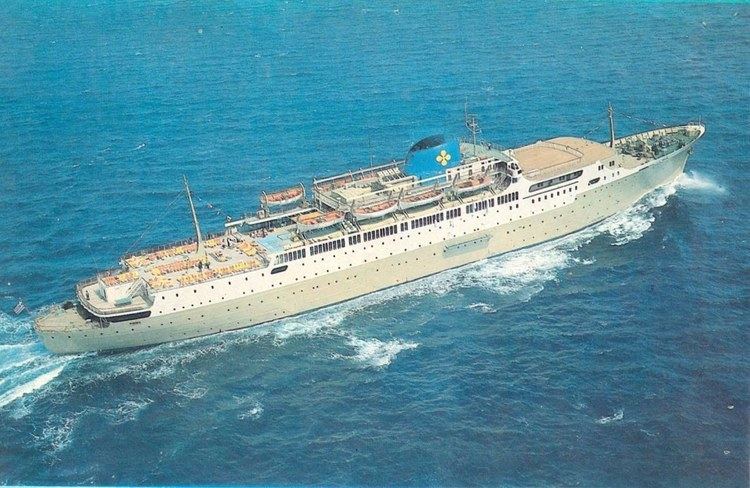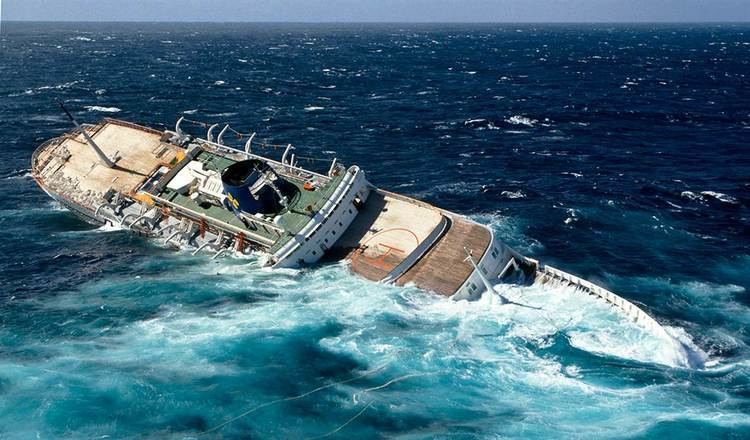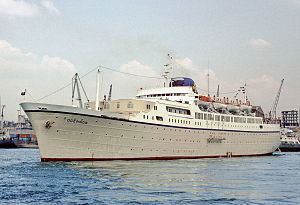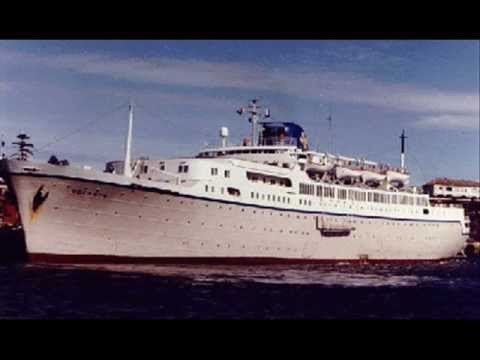Name Oceanos Owner Epirotiki Lines Length 153 m Beam 20 m | Operator Epirotiki Lines Completed June 1953 Launched 12 July 1952 | |
 | ||
Mts oceanos a tragic loss at sea
MTS Oceanos was a French-built and Greek-owned cruise ship that sank in 1991 due to uncontrolled flooding.
Contents
- Mts oceanos a tragic loss at sea
- History
- Final voyage
- Flooding
- Rescue efforts
- Final moments
- Aftermath
- Wreck
- References
History

She was launched in July 1952 by Forges et Chantiers de la Gironde in Bordeaux as the Jean Laborde, the last of four sister ships built for Messageries Maritimes. The ships were used on the Marseilles – Madagascar – Mauritius service. The Jean Laborde underwent several name changes including Mykinai, Ancona, and Eastern Princess; finally, in 1976, she was registered in Piraeus, Greece, under the name of Oceanos.

After a successful 1988 cruise season in South Africa, the Oceanos received an eight-month charter from TFC Tours (now Starlight Cruises) of Johannesburg. She was in a state of neglect, with loose hull plates, check valves stripped for repair parts after a recent trip, and a 10 cm (4 in) hole in the watertight bulkhead between the generator and sewage tank. She sank off South Africa's eastern coast on 4 August 1991 during a storm which caused leaking in the engine room and eventually flooded the ship.
The Oceanos was featured in the 1986 film Hardbodies 2.
Final voyage

On 3 August 1991, the Oceanos set out from East London, South Africa and headed for Durban. She headed into 40-knot winds and 9 m (30 ft) swells. Usually, there would have been a "sail-away" party on deck with musicians and British entertainers Moss and Tracy Hills. However, due to the rough seas, this was held inside in the Four Seasons lounge; most passengers choosing to stay in their cabins.

The storm worsened as the evening progressed and when the first sitting of dinner was served, the waiters could hardly carry the trays of food without dropping something. Eventually the ship was rolling about from side to side so badly that crockery and cutlery began sliding off the tables and potted plants were falling over.
Flooding
At approximately 21:30 UTC+2, while off the Wild Coast of the Transkei, a muffled explosion was heard and the Oceanos lost her power following a leak in the engine room's sea chest. The chief engineer reported to Captain Yiannis Avranas that water was entering the hull and flooding the generator room. The generators were shut down because the rising water would have short circuited them. The ship was left adrift.
The water steadily rose, flowing through the 10 cm (3.9 in) hole in the bulkhead and into the sewage waste disposal tank. Without check valves in there, the water flowed through the main drainage pipes and rose through the ship, spilling out of showers, toilets, and waste disposal units.
Realising the fate of the ship, the crew fled in panic, neglecting the standard procedure of closing the lower deck portholes. No alarm was raised. Passengers remained ignorant of the events taking place until they witnessed the first signs of flooding in the lower decks. At this stage, eyewitness accounts reveal that many members of the crew, including Captain Avranas, were already packed and ready to depart, seemingly unconcerned with the safety of the passengers.
Rescue efforts
As no alarm or announcement was given that the ship was in trouble, several passengers went to the bridge to look for the captain but found it unmanned. Entertainer Moss Hills then used the radio phone to broadcast a mayday until a ship answered. Nearby vessels responded to the ship's SOS and were the first to provide assistance. The South African Navy along with the South African Air Force launched a seven-hour mission in which 16 helicopters were used to airlift the passengers and crew to the nearby settlements of The Haven and Hole in the Wall (32°2′0″S 29°6′36″E), about 10 km (6.2 mi) south of Coffee Bay. Of the 16 rescue helicopters, 13 were South African Air Force Pumas, nine of which hoisted 225 passengers off the deck.
All 571 people on board were saved. Moss Hills organized the orderly evacuation of passengers by the helicopters and is generally acknowledged as the leading hero of the event. Hills and fellow entertainer Julian Butler directed the efforts of the entertainment staff, which included Tracy Hills (Moss Hills' wife) and Robin Boltman, to assist the passengers. Butler, Moss Hills and Tracy Hills were among the last five to be rescued.
After many officers and crew abandoned ship, women and children were given priority when loading the lifeboats by cruise director Lorraine Betts. Later, as the ship developed a severe starboard list that rendered the remaining lifeboats useless, the remaining passengers had to be airlifted onto South African Air Force helicopters by means of a safety harness. Betts again insisted that women and children be rescued first.
Final moments
The following day at approximately 15:30 UTC+2, the Oceanos rolled over onto her side and sank by the bow, eventually striking sand 90 m (300 ft) below the surface while more than 60 m (200 ft) of her stern remained aloft a few minutes before also slipping below, coming to rest at 32.12093°S 29.12029°E / -32.12093; 29.12029 (Oceanos wreck) on her starboard side almost at right angles to the coastline, with her bow facing seaward. The last 15 minutes of her sinking was captured on video and broadcast by ABC News.
Aftermath
Captain Yiannis Avranas deliberately and willfully abandoned his duties. He and many crew members were criticized for leaving hundreds of passengers behind with no one other than the ship's onboard entertainers to help them evacuate. Avranas tried to defend his actions by claiming that he left the ship first to arrange for a rescue effort, and then supervised the rescue from a helicopter. He justified his actions saying the "ship was in darkness and the batteries on the crew's walkie-talkies had died, meaning that he had no communications with his crew or with other rescue craft". Avranas was quoted as saying "When I order abandon the ship, it doesn't matter what time I leave. Abandon is for everybody. If some people like to stay, they can stay."
A Greek board of inquiry found Avranas and four officers guilty of negligence. In particular - in their handling of the disaster.
Epirotiki Lines had lost two other ships within the three years preceding the sinking: the company's flagship Pegasus only two months before, and the MV Jupiter, three years before.
Dateline NBC aired a documentary of this incident on 23 May 2010. The sinking is the subject of a song called "Oceanos" by Celtic rock band Coast. It was also discussed in an episode of Nova on 18 April 2012 entitled "Why Ships Sink", which focused mainly on the Costa Concordia accident (whose commanding officer also fled while passengers were still aboard) and how it related to the Titanic. Moss Hills was interviewed in the special, and related that some years later he had been on board when the MS Achille Lauro of Star Lauro sank. The rescue featured in episode 4 of Shockwave, first aired 21 December 2007. The NPR radio show and podcast Snap Judgment featured a first person account of the sinking as told by Moss Hill.
Wreck
The Oceanos wreck lies at a depth of between 92 m (302 ft) and 97 m (318 ft), about 5 km (3.1 mi) offshore. Divers have visited it, but currents are strong so diving is difficult. Photographs taken in 2002 show that the bridge section has collapsed.
